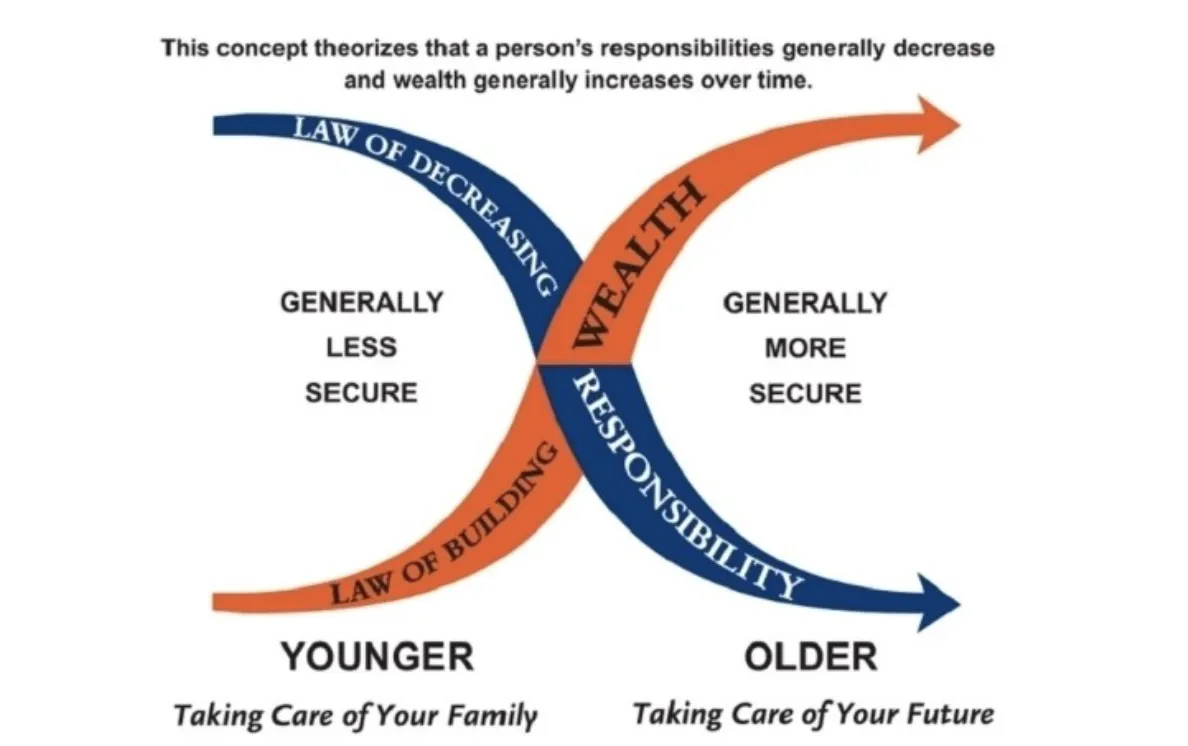The X-Curve concept is a simple yet powerful way to visualize the relationship between managing responsibilities and building wealth. It illustrates how, over time, an individual's responsibilities generally decrease while their wealth increases. Understanding this concept can empower you to take control of your financial future and secure a better life for yourself and your family.
The Theory Behind the X-Curve
When you’re young, your responsibilities tend to outweigh your wealth. At this stage:
- You may have limited savings or investments.
- Responsibilities such as children, mortgages, debts, and college savings for your family are high.
As you age and begin saving and investing, your wealth starts to grow. Ideally, by the time you retire:
- Your investments and savings (your wealth curve) will be high.
- Your financial responsibilities will have diminished, leaving you free to enjoy your later years.
The key takeaway from the X-Curve is this: The earlier you take steps to increase your wealth and reduce your responsibilities, the more secure your financial future can be.
Responsibility: The Core of the X-Curve
The X-Curve is fundamentally about responsibility. Without it, the concept holds no value. Consider these points:
- Protection for Your Family: If you neglect insurance and savings, your family could suffer if you pass away prematurely.
- Financial Independence: If you live a long life without savings, you risk becoming a financial burden on your children.
Many people prioritize short-term pleasures over long-term security, such as spending on entertainment, luxury goods, or impulsive purchases. However, this neglect can jeopardize their family’s financial stability and future well-being.
Remember: Your financial future is your responsibility. Neither the government nor your employer will prioritize it for you. Learning the basics of how money works is essential for safeguarding your family’s future.
Building Your Financial Foundation
The X-Curve provides a clear strategy for financial planning:
Early Life: High Responsibility, Low Wealth
- Responsibilities include children, mortgages, college savings, and debts.
- Insurance protection is critical to cover your family’s needs if anything happens to you.
- Start saving and investing early to build your wealth curve.
Later Life: Low Responsibility, High Wealth
- As children grow, mortgages are paid off, and debts are reduced, your responsibilities decrease.
- Focus on accelerating your savings and investments to ensure a comfortable retirement.
Pitfalls to Avoid
Some people fail to reduce their responsibilities as they age:
- Taking on bigger mortgages by purchasing larger homes.
- Accumulating additional debts or remarrying and starting new families.
These actions can result in continued high responsibility and protection needs, even in later life.
Planning for Two Possible Outcomes
In life, two outcomes are inevitable: You will either live too long or die too soon. The X-Curve prepares you for both scenarios:
- If you die too soon: High protection ensures your family’s financial stability.
- If you live too long: Adequate savings and investments guarantee your financial independence.
Take Charge of Your Future
- Protect your family while you’re young. Ensure you have sufficient insurance to cover major responsibilities.
- Save and invest consistently. Build your wealth to reduce reliance on others and prepare for retirement.
- Avoid unnecessary debt. Focus on reducing your obligations as you age.
The X-Curve is more than a financial concept; it’s a roadmap to a balanced, secure, and fulfilling life. By taking responsibility and making informed financial decisions, you can provide for your loved ones while ensuring your own peace of mind.

